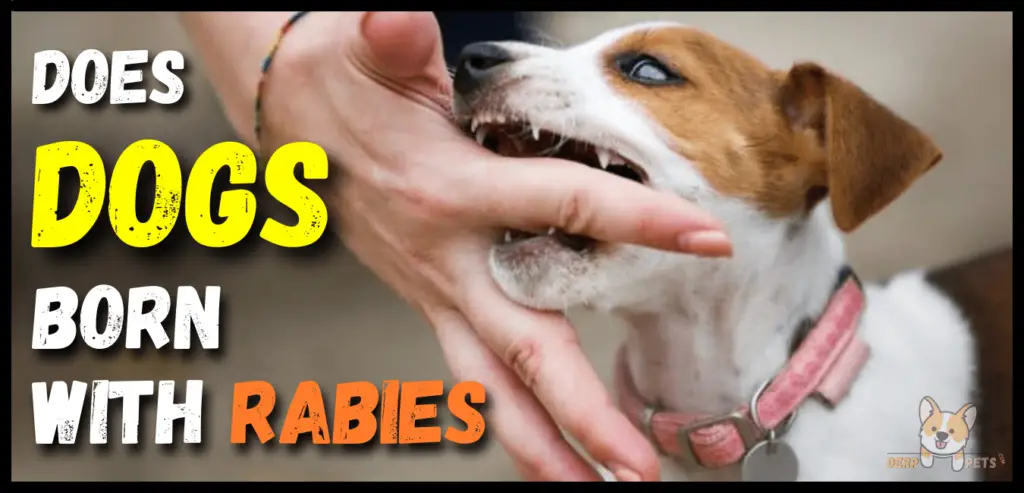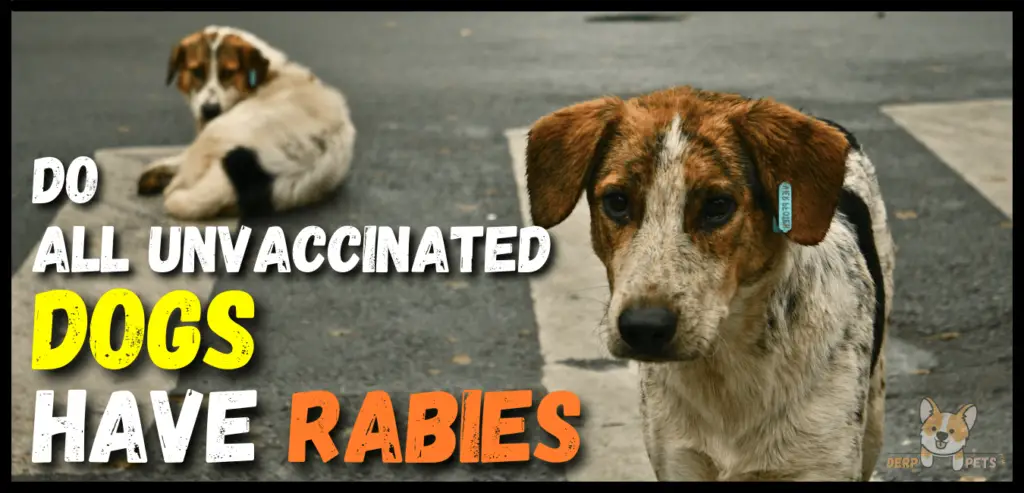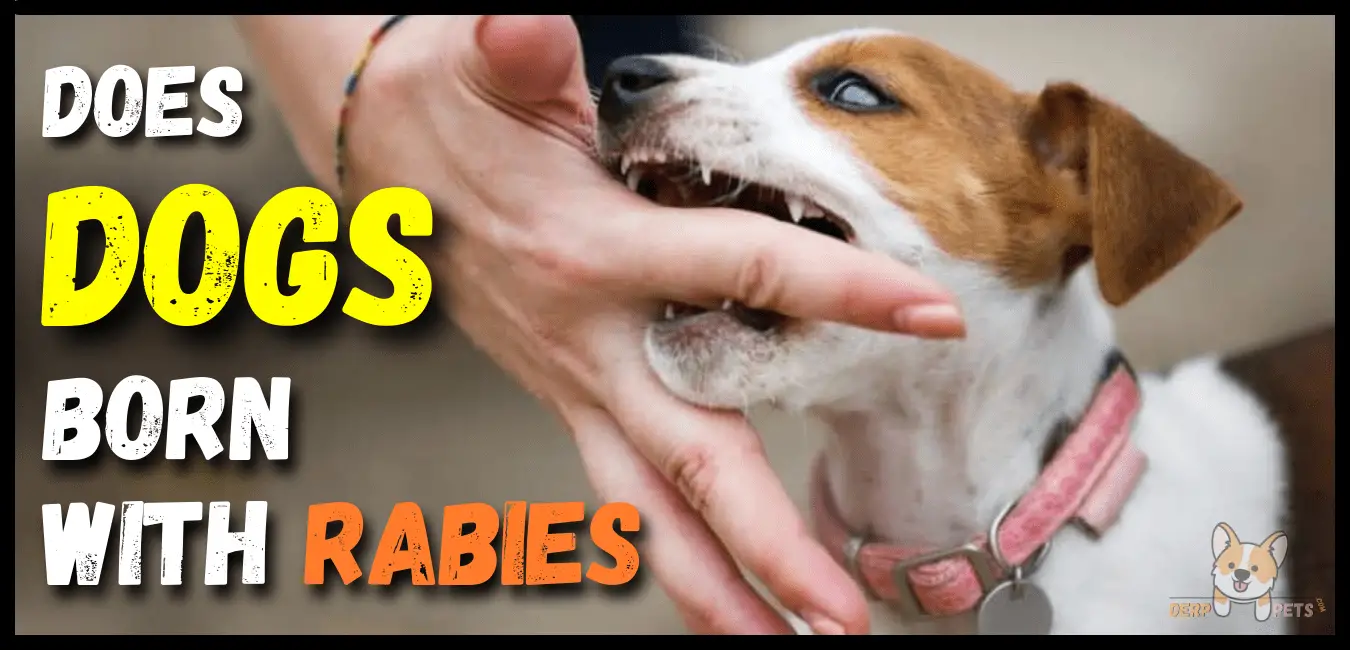
Dogs are the most common pets responsible for rabies virus transmission to their owners, which probably makes you wonder whether dogs are born with rabies or not.
Do Dogs Born With Rabies?
The answer is “NO” dogs aren’t born with rabies. Rabies is a viral disease caused by a virus, and that virus is found in the saliva of a rabid animal. It can only be transmitted in dogs if the dog is in contact or bitten by rabid animals.
There are a lot of interesting and surprising facts to mention when we’re talking about rabies.
Let’s dig deep and see what exactly the facts are!
Can Dogs Develop Rabies On Their Own
A dog can’t develop rabies on its own, and not only dogs but other pets also can’t develop the virus. It is only a 100% transmissible disease that only transfers when a dog has been bitten by a rabid animal or is in contact with rabid animals like raccoons, bats, mongoose, coyotes, even backyard woodchucks.
Not just only by bite, rabies transmission from other types of exposure is also possible.
These types of exposures include saliva or nervous tissue entering an open wound or saliva or nervous tissue coming into contact with a mucous membrane such as the eyes, nose, or mouth.
As well as little licks or scratches from rabid animals can transmit the virus too… So keep your pup safe whenever you take them out for a walk!
On the other hand, rabies is found in the body fluids of a rabid animal! That means a newly born puppy can easily catch the rabies virus directly from its mother’s milk if the mother dog already suffers from rabies.
It’s also still risky for puppies if she licks and bites them.
Plus, rabies is only infectious during its symptomatic stage. Also, in the USA, most cases are reported in bats, and less than 5% of reported cases are in dogs.
That means most dogs do not have it. Pet dogs are usually vaccinated every year, so there is typically no chance that dogs develop rabies on their own.
How Long Can A Dog Live With Rabies?
It takes around 3 to 12 weeks for a dog to begin to show signs of rabies disease; after that, the rabies-infected dog usually dies within 7 to 10 days.
The infection starts from the bite of a rabid animal! Then the virus travels from the site of the animal bite to the brain by moving within nerves. Don’t be confused here, as a dog does not appear ill during this time.
The time between the bite and the appearance of first symptoms, known as the incubation period, the period may last for weeks to months.
A bite by the rabid animals during the incubation period does not carry a risk of rabies because the virus has not yet made it to the saliva.
When the virus has reached the brain and multiplied there to cause an inflammation of the brain, it moves from the brain to the salivary glands and saliva, where dogs begin to show the first signs of rabies.
The first symptoms of rabies may be nonspecific and include lethargy, fever, vomiting, and anorexia. But the signs progress within days to cerebral dysfunction, cranial nerve dysfunction, ataxia, weakness, paralysis, seizures, difficulty breathing, difficulty swallowing, etc.
Most of these signs are visible to even an untrained observer, but within 3 to 5 days, the virus can easily damage the brain enough where the dog has to lose its life.
Don’t ever think you can protect your pet from rabies without the proper vaccinations__It could be a horrific death.
Can Humans Get Rabies From Puppies?
Yes, there is a 100% chance for humans to get rabies directly from puppies. Unless the puppy is fully vaccinated and never fights or gets in touch with rabid wild animals like raccoons, bats, Coyotes, etc.
It is little easy to identify whether a puppy is infected by rabies or not, as puppies infected with rabies suffer more than an adult dog.
In the beginning, the puppy may show behavior changes, which means a very energetic puppy becomes more docile, as well as a friendly one, can definitely become irritable.
Plus, you can also observe things like fear of water, excess salivation, change in gait even some time they also start eating abnormal substances like rocks, dirt, etc.
So if a rabid dog bites you and breaks the skin or draws blood or there are puncture wounds, that means the infected saliva has entered your bloodstream. In that case, standard anti-rabies procedures need to be followed immediately.
Rabies is a fatal but preventable viral disease, especially in the United States, because here rabies is often found in wild animals like bats, raccoons, skunks, and foxes.
So, if you are from the United States, don’t worry too much as it’s pretty rare to get rabies virus from dogs in the United States: as almost all dogs are correctly vaccinated here.
But still better, if you quickly wash the bite or scratch thoroughly and apply an antiseptic, and do consult with your doctor.
However, in many other continents like Asia and Africa, dogs still carry the rabies virus, and it’s best not to take any bite or scratch lightly there.
What Happens If A Puppy Bites You?
If the puppy hasn’t been exposed to dangerous diseases like rabies, you are most likely safe. Just wash the wound and treat it with antibiotics if necessary and keep it bandaged up for a few days.
However, if the bit is too deep, and some signs are visible like Fever, swelling, redness, pus, increased pain, etc. So, in that case, You will need to see a doctor as soon as possible.
Do All Unvaccinated Dogs Have Rabies

Simply the answer is “No,” it can’t be possible for all unvaccinated dogs to have rabies virus, especially when a dog has no physical contact with any rabid animal that makes them secure from the virus naturally. The dog will never cause rabies, and it doesn’t matter whether the dog is vaccinated or not.
But sometimes, it’s hard to say whether the dog has a rabies virus or not because sometimes they don’t so any sign of rabies!
Dogs that do not show any signs of rabies may be incubating the virus, but they are not infectious until just before they begin to show symptoms.
(As we will look at it in seconds, the word incubating can be confusing here. So let’s call it dogs that take very long to show any signs of rabies).
In case you bit by unvaccinated dogs, ask your physicians what the next step is, as rabies virus is not the only problem here, there could be more than that.
If the dog is free from the rabies virus, he can still transfer some fatal bacterial infections in humans including, Brucella, Salmonella, Campylobacter, Yersinia enterocolitica, Pasteurella, etc.
However, if you found any non rabid, unvaccinated dogs in your vicinity, you can get your local vet to vaccinate them, so they’re safe if they get bitten, and so are the humans around.
Can A Dog Carry Rabies Without Showing Symptoms?
Yes, they can, and that process is naturally known as incubation, in which dogs that do not show signs of rabies may be incubating the virus, but they are not infectious until just before they begin to show symptoms.
Plus, it is proven by studies that dogs can incubate rabies virus for months, even for years, without a single sign of rabies virus.
However, the virus can be infectious to others only when the dog is in his last stages of the disease.
In the last stages of rabies disease, the Central Nervous System of the Animal is affected. That means the brain and spinal cord. Once this happens, the salivary glands begin to hold high concentrations of the rabies virus.
Basically, dogs that have been infected with rabies will show no sign of their infection until the rabies virus travels up the nerves toward and into the brain.
Once the brain becomes involved with the virus, the dog’s behavior will change, and at the same time, the dog will shed the virus into its salivary glands that can easily infect anyone.
Can A Dog With Rabies Survive?
Yes, there are around 10% to 15% chances when dogs can survive from the rabies virus. That means 15 in 100 rabid dogs would easily persist off rabies virus without even a single shot of rabies vaccination or treatment.
The reason for dog survival from rabies virus is pretty simple, sometimes a dog’s body produces antibodies on its own after being exposed to the virus that allows dogs to live.
And not only in dogs, but other animals and humans can also antibody their bodies against rabies.
Here is quick proof! A study done in Peru led by Amy Gilbert of the U.S. Centers for Disease Control and Prevention found that 7 out of the 63 people tested positive for rabies antibodies.
Of those seven people, only one had previously taken the Rabies vaccine. That meant that the other six had produced antibodies and survived after being exposed to the virus.
Don’t take this too serious, as not all humans are lucky like those seven people!
If you get bitten by a rabid animal, don’t take a chance__take vaccine shots! And, of course, vaccinate your pet as well!

